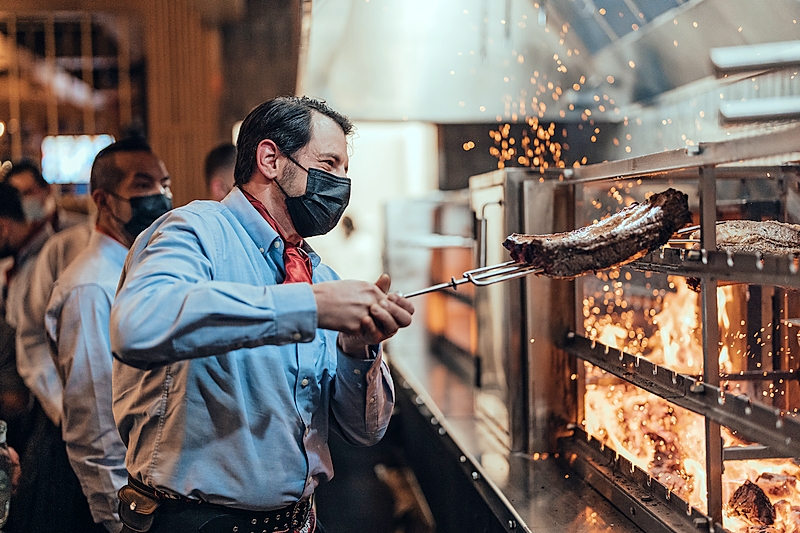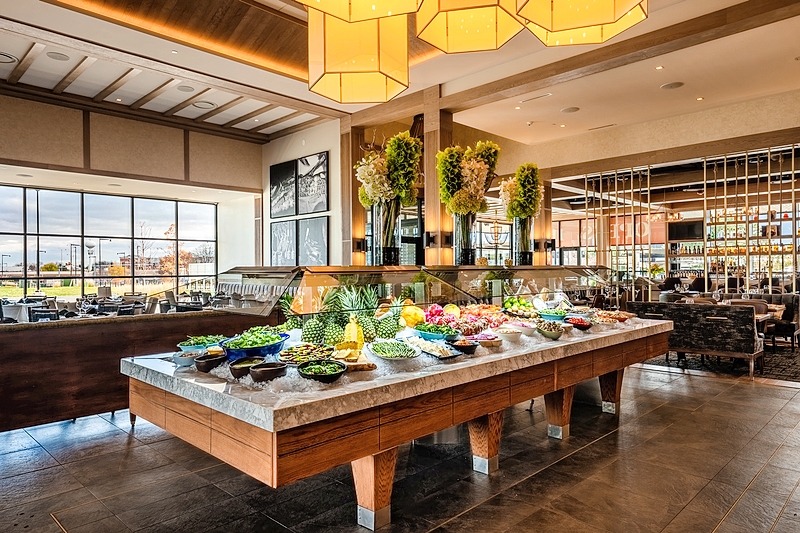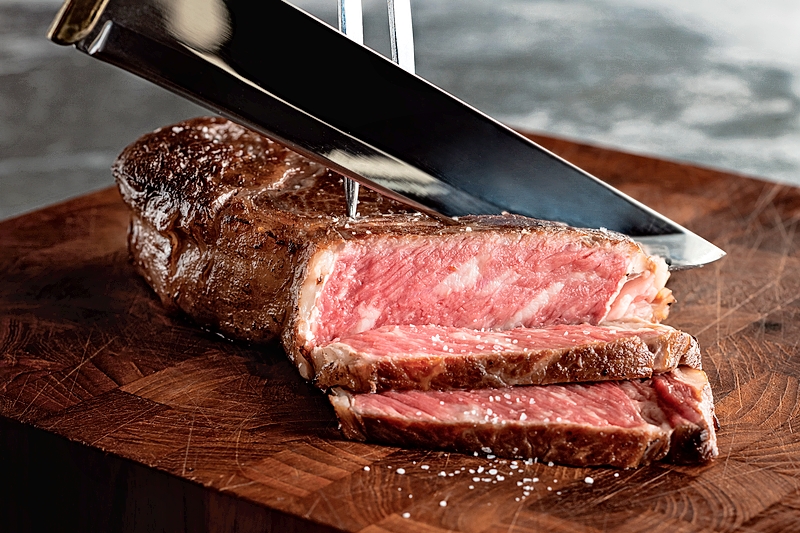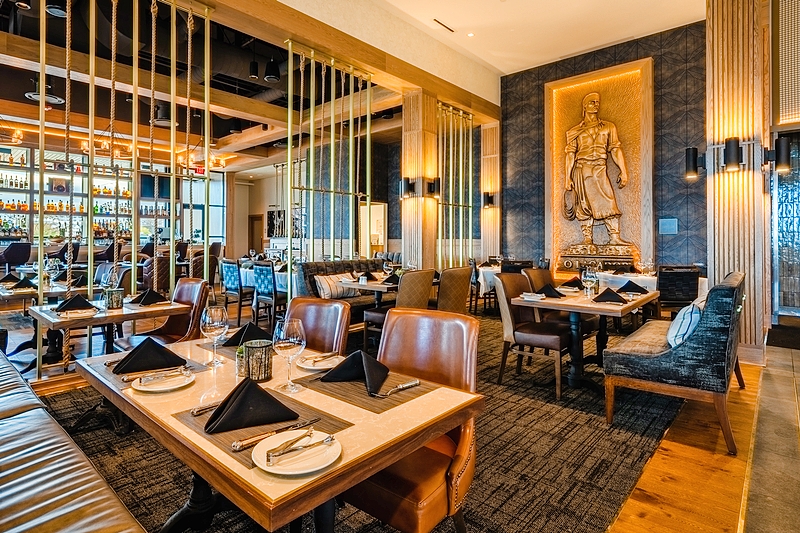Chão Chow
By Naperville Magazine
February 2022 View more Table for Two

By Phil Vettel
The opening of a new Fogo de Chão outpost in Oak Brook is not exactly earth-shattering news. There are, after all, three other locations in the Chicago area, including Naperville (in the Freedom Commons complex) and Rosemont.
But it’s worth noting how this concept has survived, and thrived, in a market in which the competition among steak-focused restaurants is intense. It was 2002 when Fogo de Chão opened in River North, becoming the first Brazilian churrascaria in the city (another chain, Sal y Carvao, operated in the suburbs). By 2005 there were seven operations in the city and suburbs—names such as Asado Brazilian Grill, Brazzaz, Texas de Brazil, and Sabor do Brazil—and the Chicago area had more churrascarias than one could shake an espeto at.
If you’re unfamiliar with the concept, churrascaria refers to open-fire roasting, as practiced by the nomadic gauchos (cowboys) of the South American pampas (plains). Service is rodizio style, meaning a cadre of servers/gauchos roam from table to table, bearing unlimited samplings of beef, chicken, pork, and lamb. Flip your table’s color-coded disk to green, and they’ll stop by; flip it back to red to be left alone to digest. The experience also includes a sizable salad bar and several brought-to-table side dishes.

Even at a set price (at dinner) of $58.95, the calories-per-dollar ratio is impressive. Combine that with the trappings of fine dining (upscale decor, soft lighting, sophisticated wine selection) and a whiff of the exotic, and what’s not to like?
And yet today, most of those churrascaria concepts have left the Chicago market. Besides Fogo de Chão, all that remain are Texas de Brazil (locations in Schaumburg and Orland Park) and Chama Gaucha in Downers Grove (created by a longtime Fogo employee). Meanwhile, Fogo de Chão has expanded into Oak Brook, where steakhouses (Ditka’s, Gibsons, Michael Jordan’s, Perry’s, Wildfire) are not exactly in short supply.
There’s plenty of reason to think that Fogo de Chão can run with these big dogs; indeed, this particular outpost, sitting immediately east of Oakbrook Center, seems to be taking dead aim at them. The space is gorgeous, its jumbo size (260 indoor seats, though you’d never guess it) cleverly divided into smaller areas that add intimacy, even as the soaring ceilings and contemporary chandeliers give the interiors a sense of grandeur. An open churrasco bar, a first for the chain, lets diners watch the cooking, and offers an additional à la carte menu for the cocktail-and-appetizers crowd (including daily happy-hour specials).
In addition to the dining room’s all-you-can-eat format, there also are à la carte “indulgent cuts” of dry-aged beef (sized for four and priced accordingly) for those craving high-quality beef, and sharable “indulgent appetizers” of seafood-towers, shrimp cocktails, and lobster-shrimp platters.

In Fogo’s early days, the restaurant adhered to the churrascaria tradition that meats be seasoned with only salt, since roaming gauchos would have nothing else available. This could lead to a certain palate fatigue, as every protein was seasoned the exact same way. Now there is some variety; beef cuts still rely exclusively on salt-and-charcoal preparation, but there are hints of lemon pepper in the pork cuts, a whiff of mint in the lamb, and a citrus marinade flavors the chicken items.
To maximize your experience here, consume judiciously. Beware, for example, the pao de queijo: the freebie cheese puffs that are addictive, but treacherously filling. (You’ll never be able to resist entirely, but try to pace yourself.) The mashed potatoes, polenta, and caramelized bananas (all brought to the table, unbidden) are also space-eaters, not to mention the massive Market Table (go for the roasted veggies, take it easy on other items).
As to the meat itself, the goal here is not so much limiting one’s intake as it is being sure to get exactly what you want. Not all of the meats are cooked to the same temperature, for instance, so be sure to make your preferences known. When a gaucho arrived with a skewer of picanha (top sirloin), I asked for medium-rare meat, and the server knew just where to slice. A subsequent gaucho with a different cut told me there was no medium-rare meat left on his skewer, but that he’d return with a new one. A few minutes later, he did. And if you have a taste for a particular item, feel free to ask the nearest gaucho (even if he happens to be serving chicken legs), who’ll send the appropriate server your way.

What to look for? Picanha is the restaurant’s signature cut, not to be missed. Also terrific is the lamb picanha, its rich flavor augmented by a dose of black pepper. Bacon-wrapped fillet, rib-eye steak, lamb chops—yes, yes, yes. Linguica, the well-seasoned pork sausage, is a highlight.
Useful strategies for those cutting costs and/or calories is to visit at lunch or weekend brunch, when the fixed price ($58.95) drops a bit ($39.95 lunch, $42.95 brunch). You also can opt for Market Table only ($30.95), or augment the Market Table with one à la carte meat dish (a popular option at lunch, I’m told).
Photos courtesy Fogo de Chão


